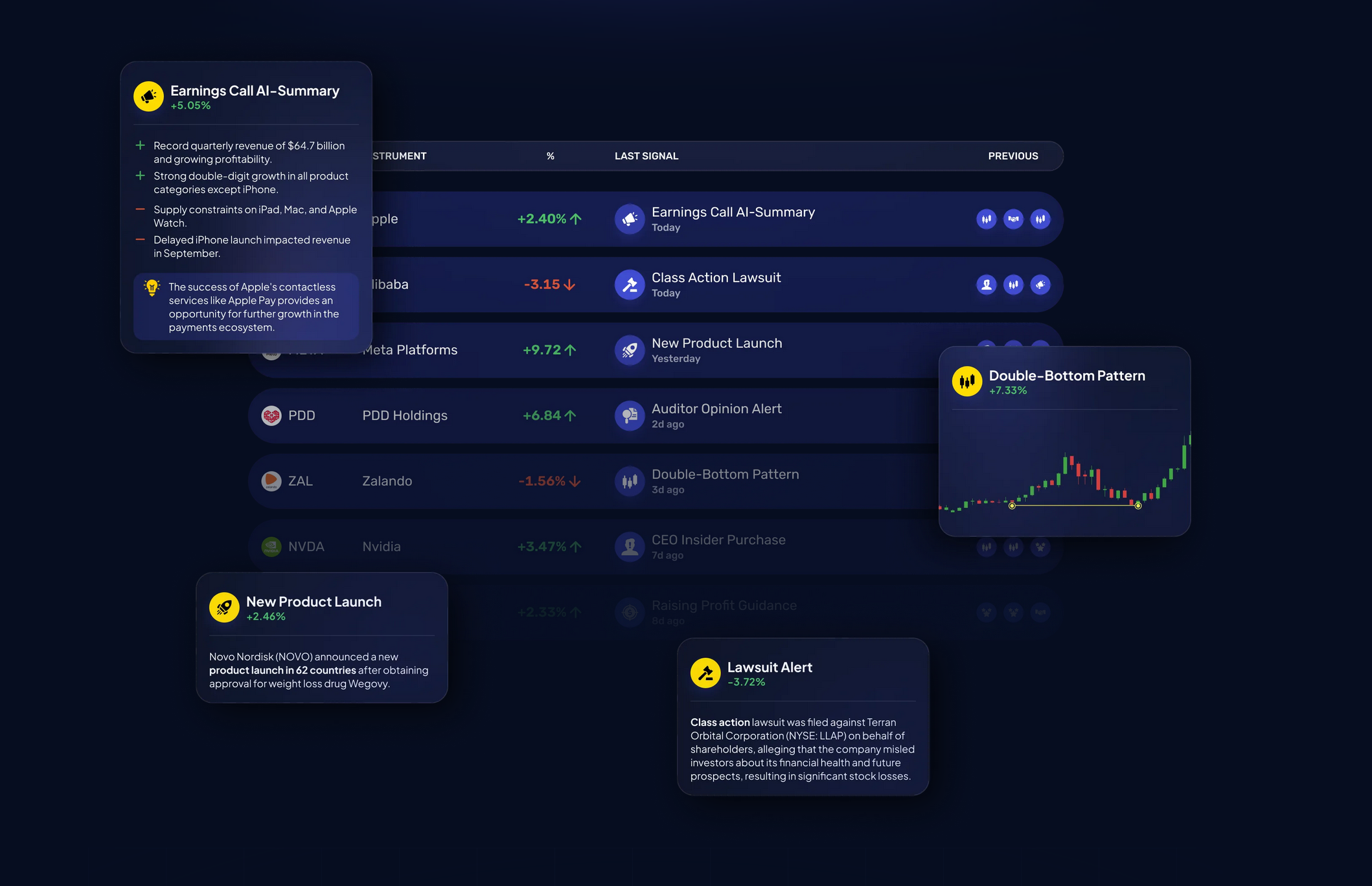20 Handy Tips On Choosing AI Stock Trading Platform Sites
20 Handy Tips On Choosing AI Stock Trading Platform Sites
Blog Article
Top 10 Tips For Assessing The Data Sources And The Quality Of Ai Trading Platforms For Stock Prediction And Analysis.
In order to provide accurate and reliable information, it's important to check the data and sources that are utilized by AI stock prediction and trading platforms. A poor quality data source can result in inaccurate predictions as well as financial losses, and a lack of trust of the system. These are the top 10 tips for evaluating data quality and sources:
1. Verify the source of data
Verify the source of the information. Make sure that the platform uses credible, reliable sources of data (e.g. Bloomberg Reuters Morningstar, or stock exchanges such NYSE, NASDAQ).
Transparency. A platform that is transparent should reveal all the sources of its data and keep them updated.
Avoid dependence on a single source: Trustworthy platforms aggregate information from multiple sources in order to eliminate biases and mistakes.
2. Examine the freshness of data
Real-time data vs. delayed data: Find out whether the platform offers actual-time data, or delayed data. Real-time data is vital in order to facilitate trading, while delayed data can be sufficient for analysis over the long term.
Update frequency: Make sure you check when the data has been changed.
The accuracy of data from the past Make sure that data is uniform and free of anomalies or gaps.
3. Evaluate Data Completeness
Look for missing or incorrect information.
Coverage - Make sure the platform you select is able to cover all the stocks, indices and other markets that are relevant to trading strategies.
Corporate actions: Check that the platform can account for stock splits or dividends. Also, make sure it accounts for mergers.
4. Accuracy of Test Data
Cross-verify data: Compare the platform data with that of other trustworthy sources to ensure the accuracy.
Error detection: Check for outliers, price points or financial metrics.
Backtesting. Utilize old data to test your trading strategy and see whether it is in line with expectations.
5. Take a look at the data Granularity
Detail: Make sure the platform provides granular data including intraday price and volumes spreads, bid-ask spreads and order book depth.
Financial metrics: Check if the platform includes detailed financial statements (income statement, balance sheet, cash flow) and important ratios (P/E, P/B, ROE, etc. ).
6. Check Data Cleaning and Processing
Data normalization - Ensure the platform normalizes your data (e.g. adjusts for splits or dividends). This helps help ensure the consistency.
Outlier handling: See how the platform deals with outliers or anomalies in the data.
Missing estimation of data: Ensure that the platform is based on reliable methods for filling the gaps in data.
7. Evaluate the data consistency
Timezone alignment - Ensure that all data is aligned with the same local time zone in order to avoid any discrepancies.
Format consistency: Ensure your data is presented in a consistent manner.
Cross-market consistency: Check that the data of different markets or exchanges is aligned.
8. Assess Data Relevance
Relevance of your trading strategy. Ensure that the data corresponds to your style of trading.
Selection of features : Ensure that the platform has relevant features that can help you make better prediction.
9. Examine Data Security and Integrity
Data encryption: Ensure that the platform is using encryption to safeguard data while it is transferred and stored.
Tamper-proofing : Ensure that the data hasn't been manipulated by the platform.
Check for compliance: The platform must be in compliance with laws on data protection.
10. Transparency in the AI Model of the Platform is evaluated
Explainability: The platform must provide insights into how AI models employ data to make predictions.
Bias detection - Examine to see if your platform actively monitors models and data for biases.
Performance metrics: Evaluate the track record of the platform and performance metrics (e.g., accuracy and precision, recall) to determine the accuracy of its predictions.
Bonus Tips
Reviews and feedback from users: Use reviews and user feedback to assess the credibility of a platform as well as the accuracy of its data.
Trial period: Test the platform for free to see how it works and what features are available before committing.
Customer Support: Ensure that the platform has an efficient support system for customers to help resolve issues with data.
These tips will allow you to evaluate the data quality, the sources, and the accuracy of AI-based stock prediction tools. Read the best incite tips for website advice including chatgpt copyright, chatgpt copyright, using ai to trade stocks, best ai for trading, ai investing platform, options ai, ai investment app, ai investing platform, ai for stock trading, market ai and more.
Top 10 Tips For Assessing The Regulatory Conformity Of Ai Stock Predicting/Analyzing Trading Platform
When it comes to evaluating AI trading platforms, compliance with regulatory requirements is critical. Compliance ensures that the platform adheres to financial regulations and adheres to legal frameworks and protecting the user's information. This minimizes the chance of financial penalties or legal problems. Here are the top 10 guidelines to evaluate the compliance with regulations of these platforms:
1. Verify the Licensing & Registration
Regulators: Confirm that the platform is registered and licensed by the relevant financial regulatory authority (e.g. SEC, FCA, ASIC, etc.) in your nation.
Make sure that the brokers integrated into the platform are licensed and monitored.
Public Records: Visit the website of your regulator body to find out information about registration status, past violations and other relevant information.
2. Measure Data Privacy Compliance
GDPR: When operating in the EU or offering services to customers in the EU the platform must comply with the General Data Protection Regulation.
CCPA: California Consumer Privacy Act compliance is required for users.
Data handling policies: Go through the policy of the platform on data privacy to make sure that it clarifies exactly how data from users are collected, stored and shared.
3. Assessing Anti-Money Laundering measures
AML Policies The platform should be equipped with strong AML (Anti-Money Laundering) policies that detect the money laundering process and stop it.
KYC procedures: Check whether the platform is following Know Your Customer (KYC) procedures for verifying identity of the user.
Check the platform's transaction monitoring. Does it monitor transactions and report any suspicious activity to the authorities?
4. Make sure you're in compliance Trading Regulations
Market manipulation: Ensure the platform has safeguards to prevent market manipulation, such as spoofing or wash trading.
Order types. Check to see if your platform complies with the rules for order types.
Best execution: Make sure to see if the platform follows the best execution practices to ensure that trades will be executed at the lowest cost.
5. Cybersecurity Compliance:
Data encryption: Make sure the platform safeguards your data during transport and at rest with encryption.
Incident response. Verify that there is clearly identified incident response plan for the platform to address cyber attacks and data breaches.
Verify certifications.
6. Transparency & Disclosure:
Disclosure of fees: Ensure that the platform is transparent about all fees including hidden or additional fees.
Risk disclosure: Make sure the platform provides clear risks and disclosures. This is especially important for trading strategies with high leverage or risks.
Performance reporting: Check if the platform provides transparent and accurate performance reports for its AI models.
7. Check the Compliance to International Regulations
Trading across borders: If you trade internationally, ensure your platform is compliant with the laws in all jurisdictions that apply to it.
Tax reporting: Determine if a platform has tools or reports to allow users to adhere to tax laws.
Conformity with international sanctions: Ensure that the platform adheres strictly to these regulations and doesn't permit trading between prohibited countries or entities.
8. Review Audit Trails and Record-Keeping
Transaction records: Ensure that the platform has detailed records of all transactions to be used for audits and regulatory purposes.
Logs of user activity (logs): Check to check if the platform records the activities of users, such as trading and logins. Also, verify if the settings for your account have been altered.
Check for audit readiness: Determine whether your platform is able to provide the required logs and documentation in the case of an inspection by a regulatory agency.
9. Check for the compliance of AI Specific Regulations
Algorithmic Trading Rules: If your platform supports algorithmic trading, ensure it is compliant with the regulations such as MiFID II (in Europe) or Reg SCI (in the U.S.).
Fairness and bias Check if the platform mitigates or monitors its AI models to ensure ethical and fair trading.
Explainability - Make sure that the system is able to provide clear and concise explanations regarding AI-driven decisions, predictions and more. as required by specific rules.
Review User Feedback & Review History of Regulatory History
User reviews: Use user feedback to determine the platform's regulatory conformity.
Historical Record: Search for any past violations of regulations and penalties, fines or sanctions.
Third-party auditors: Make sure that the platform is regularly audited by third parties to make sure it is adhering to regulations.
Bonus Tips
Legal consultation: Consult an expert in the field to verify whether your platform is compliant with laws.
Trial period: Test the platform for free, or try the demo to test its compliance features and documentation.
Customer support - Check that the platform is able to assist with any compliance related questions or issues.
Use these guidelines to assess the compliance with regulations and protect of your rights. Compliance is crucial as it does not just reduce legal risks, it also increases trust and confidence for the platform. Check out the top link for chart analysis ai for blog examples including trading ai tool, how to use ai for stock trading, ai copyright signals, best ai for stock trading, how to use ai for stock trading, ai options trading, ai stock price prediction, ai options, ai tools for trading, ai for trading stocks and more.